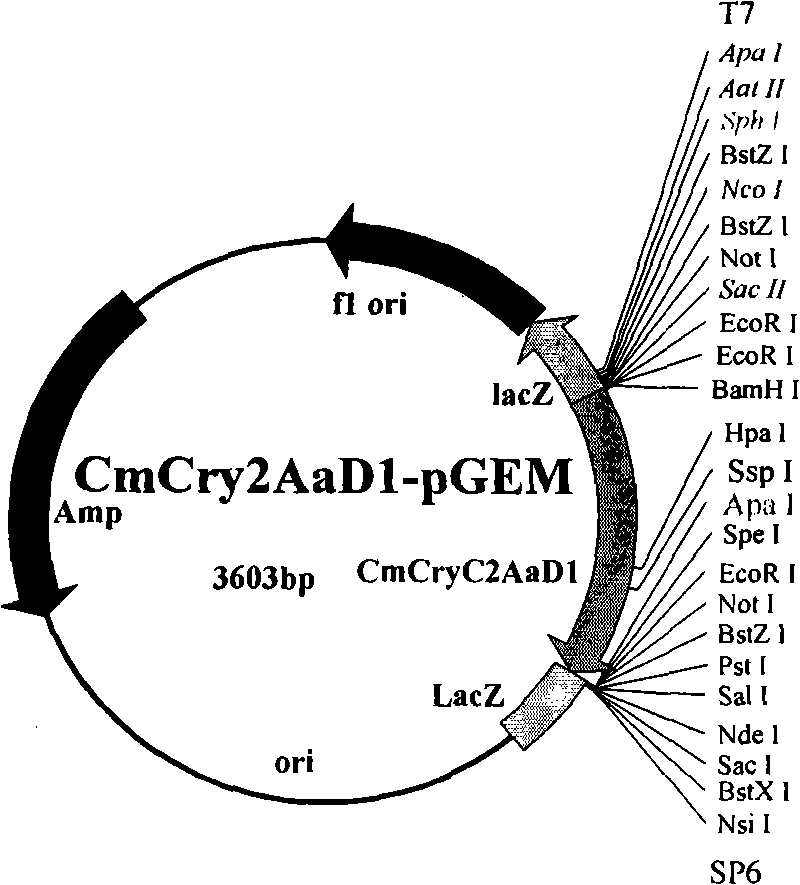Artificial reconstruction synthetic pesticidal gene as well as encoding protein and use thereof
A technology of insecticidal genes and proteins, applied in the fields of application, genetic engineering, plant genetic improvement, etc., can solve problems such as ecological imbalance and increased resistance of pests
- Summary
- Abstract
- Description
- Claims
- Application Information
AI Technical Summary
Problems solved by technology
Method used
Image
Examples
Embodiment 1
[0052] Example 1 Synthesis of CmCry2Aa insecticidal gene
[0053] 1. According to the amino acid sequence of Cry2Aa insecticidal protein and cotton codon usage, three gene fragments for constructing CmCry2Aa insecticidal gene were designed and synthesized respectively. Gene synthesis was entrusted to Beijing Aoke Company.
[0054] According to the design, the codon usage of the synthetic CmCry2Aa insecticidal gene is as follows:
[0055]
[0056] Note: The three numbers after the symbol of the amino acid encoded by each codon in the above table represent: number of codons / occurrence frequency in protein (‰) / codon usage (%)
[0057] Domain I (Domain I) DI gene fragment: BamHI-ATG-DI-ApaI, its specific sequence is shown in: SEQNO ID: 5.
[0058] Domain II (DomainII) DII gene fragment: ApaI-DII-SspI, its specific sequence is shown in: SEQ NO ID: 6.
[0059] Domain III (DomainIII) DIII gene fragment: XbaI-HpaI-DIII-SacI, its specific sequence is shown in: SEQ NO ID: 7.
...
Embodiment 2
[0063] Example 2 Construction of CmCry2Aa insecticidal gene plant expression vector M1-BAR-35S-CmCry2Aa
[0064] Have the plasmid CmCry2Aa-pUC57 of complete CmCry2Aa insecticidal gene, further follow as Image 6 The procedure described constructs the plant expression vector M1-BAR-35S-CmCry2Aa. The PCR identification results and enzyme digestion identification results of the screening and identification during the construction of the plant expression vector M1-BAR-35S-CmCry2Aa are as follows: Figure 7 and Figure 8 as shown, Figure 7 Lanes 1, 2 and 3 represent target bands amplified using clones 1, 2 and 3 as templates, and "+" represents target bands amplified using plasmid M1-BAR-35S-CmCry2Aa as a template (positive control), "-" represents that the target band was not amplified using water as a template (negative control); Figure 8 Middle 1 lane is the restriction endonuclease Xba I+SacI cut plasmid M1-BAR-Tnos-Gus, cut off GUS, about 1.8Kbp, 2, 3, 4, 5 and 6 lanes a...
Embodiment 3
[0065] Example 3 Obtaining tobacco with CmCry2Aa insecticidal gene
[0066] Using Agrobacterium-mediated leaf disk method to transform tobacco (a method well known to researchers in the field), and screened by PPT rooting, 46 resistant plants were obtained, the total DNA of resistant tobacco leaves was extracted, and PCR identification was carried out, and 27 positive plants were screened out , and carried out anti-cotton bollworm feeding insect test, each leaf received 5 newly hatched larvae, and after three days the results were as follows: Figure 9 As shown, 1 is the non-transformed CFM CmCry2Aa insecticidal gene tobacco leaves, 2, 3 and 4 are respectively transformed CmCry2Aa insecticidal gene tobacco leaves, the results show that the synthesized CmCry2Aa insecticidal gene has a very prominent anti-cotton bollworm effect. After investigation, the average corrected mortality rate of cotton bollworm was 93.3%.
PUM
 Login to View More
Login to View More Abstract
Description
Claims
Application Information
 Login to View More
Login to View More - R&D
- Intellectual Property
- Life Sciences
- Materials
- Tech Scout
- Unparalleled Data Quality
- Higher Quality Content
- 60% Fewer Hallucinations
Browse by: Latest US Patents, China's latest patents, Technical Efficacy Thesaurus, Application Domain, Technology Topic, Popular Technical Reports.
© 2025 PatSnap. All rights reserved.Legal|Privacy policy|Modern Slavery Act Transparency Statement|Sitemap|About US| Contact US: help@patsnap.com



